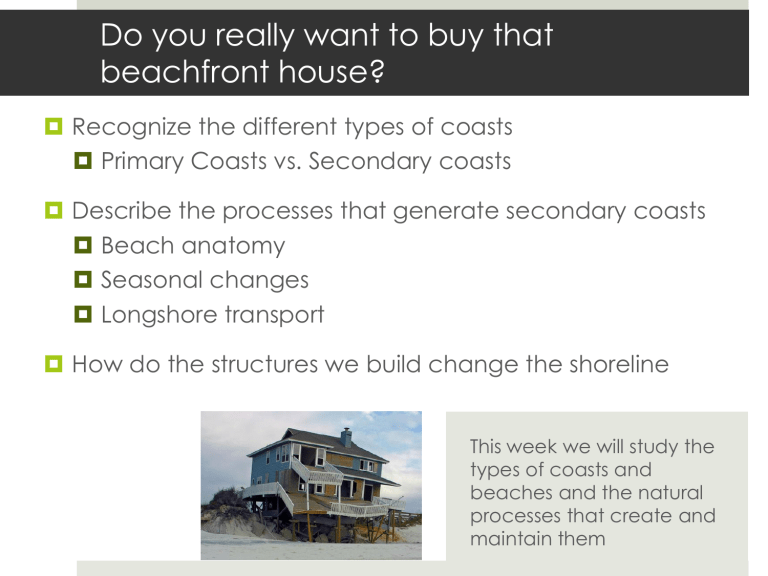Here today, gone tomorrow: sediment transport and beach evolution

Do you really want to buy that beachfront house?
Recognize the different types of coasts
Primary Coasts vs. Secondary coasts
Describe the processes that generate secondary coasts
Beach anatomy
Seasonal changes
Longshore transport
How do the structures we build change the shoreline
This week we will study the types of coasts and beaches and the natural processes that create and maintain them
Here today, gone tomorrow: sediment transport and beach evolution
The shore takes on many forms along the
WA coast and Puget
Sound
Weather, waves and gravity continue to shape the shorelines
Beaches are dynamic
Anatomy of a beach
Berm: ledge or terrace with flat tops
formed by wave-deposited material
Beach face: seaward slope, dependent on sediment type and wave energy
Troughs and bars run parallel to beach
Change seasonally
Fig. 12.6
Seasonal Beach Changes
The small waves of summer move sand from offshore to the beach and form a summer berm
Summer Profile
The high waves and storms of winter erode sand from the beach and store it in offshore bars.
Winter conditions remove the summer berm, leaving only the winter berm on the beach.
Winter Profile
Fig. 12.19
Sands shift with the seasons
Most beaches in WA consist of a shallow covering of sand or gravel over rocks
Winter: storms remove most of the sand, exposing cobbles and underlying rock
Summer: sand returns
At South
Whidbey State
Park, sand bars cover the lower portion of the gravel beach.
Sand moves with the seasons and storms, sometimes covering much of the beach, other times being drawn offshore
How do waves move sediments?
Wind = waves
Breaking wave = turbulence
Swash moves sediment onshore diagonally
Backwash moves sediment straight down beach
Swash + backwash = zigzag
http://www.youtube.com/watch?v=tN42EWWTP3w&feature= related
Fig. 12.20
How do waves move sediment?
Winds blow, waves form
As a wave approaches shore, it feels the bottom (surf zone)
speed changes, wave steepens and begins to break
The turbulence generate from the breaking wave tumbles beach material
(beach absorbs some of the waves energy)
The “stronger” or more energetic a wave is, the more sediment it stirs up and tumbles
Waves moving toward shore transport sediment onshore (called onshore transport)
Wave angle results in the transport of sediment parallel to shore
Up-rush or swash from breaking waves moves sediment diagonally up and along beach in direction of longshore transport
http://www.youtube.com/watch?v=U9EhVa4MmEs
Backwash moves sediment downslope
Sources & Sinks
Waves carry materials from eroding bluffs (source) and move them along the beach (drift path) to a spit, bar, tombolo, or beach (sink)
.
Longshore transport is interrupted by headlands, inlets, and sharp bends in the shore contours and manmade obstacles
The shoreline is divided into "drift sectors,” each drift sector contains its own pick-up (source) and drop-off points (sinks)
Sources along the WA coast and Puget Sound include eroding bluffs, rivers, and streams
Sinks appear as spits, bars, tombolos, beaches (…can also be a source if supply is blocked or changes….)
Sink or Source?
Source:
Sink:
Direction of drift or longshore transport: spit bluff
Understanding Beach Evolution
Beaches are regions of coasts where sediments (usually sand or coarser particles) are accumulating.
The source of beach sediment is rivers and the erosion of bluffs and headlands.
Beaches are particularly dynamic environments, constantly changing in size and shape as a result of wave action and longshore transport.
During the summer, waves tend to be gentle and transport sediment landward. Beaches are at their widest during the summer.
During the winter, storms at sea produce larger waves that erode beaches and transport the sediment seaward.
Longshore transport also alters the shape and profile of a beach.
Where wave action is strong, sediment is eroded and transported.
Where wave action is reduced, sediment is deposited.
Human intervention in natural beach evolution
Wave action and longshore transport can erode beaches and be a hazard to boat harbors
Build structures to stop beach erosion and stabilize beaches
jetties, groins, seawalls
People have taken measures to minimize those undesirable effects
(with mixed results)
Build structures to protect harbors
Breakwaters
Building dams
Beaches: River of Sand
To end






